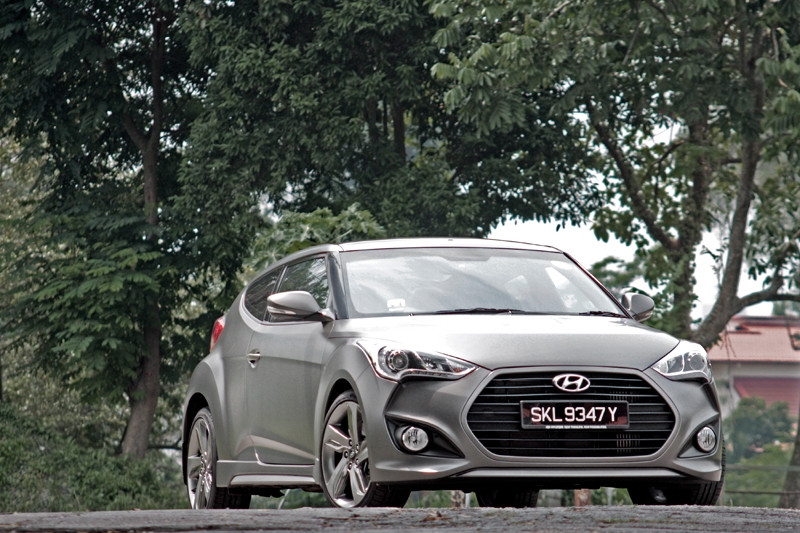Hyundai’s turbocharged Veloster is a gem of a car that is just, unfortunately, forgotten
Photos by Azfar Hashim
Yes, yes, yes. I know, I know, I know. Hyundai’s Veloster is not a new model; in fact it has been around for more than two years already. Many publications had reviewed the car, and everyone had already forgotten about it.

Which is the biggest case of oh-how-unfortunate. The Veloster is a very interesting car; the Picasso of coupes, if I may be bold. Sure it’s a three-door coupe, a concept Mini already came up with in the form of their Clubman. But the thing is this: the Veloster has the extra rear door at the right place, and the rear can actually accommodate passengers easily and comfortably.

Then along came a turbocharged variant, which is the car I am going to talk about today. Again, it’s nothing new but when it was first introduced, the Veloster Turbo was severely overshadowed by the Scirocco TSI. Well, no guess as to who got the bigger interest between the two.

But until the new Scirocco arrives, the Veloster Turbo is the coupe of the moment. First of all, there’s that timeless exterior; unlike the Tuscani that aged 341 years into production, the Veloster’s dramatic lines and creases ensures it goes into the "Top 10 Timeless Cars†when I do eventually publish the book in, say, 2020 (other cars in my list are the 650S, 458 Speciale, Satria Neo R3, Megane II RS, E-Type, just to name a few)…

And although some might opine the matt grey paintwork seem to mimic BMW and Audi, I must say it seem to work well with the Veloster too. And just in case you’re wondering, it came straight from the factory.

18-inch alloys wrapped in 225/40 R-18 Kumho rubbers come standard, along with an extra-large sunroof, those in-yer-face rear foglamp and central-mounted twin exhaust pipe. Hiding the rear door catch on the C-pillar is another brilliant idea, aesthetically speaking.

Interior wise, the Veloster is not your typical Korean – design wise, that is. You can see Hyundai’s designer being bold with those V-shaped centre console, nicely sized leather-wrapped steering wheel and free-flowing grab handle on the door panels. Unfortunately though, those grab handles creak when the passenger hold on to it during spirited driving – we need some better quality plastic here.

The rest of the interior is your typical Korean: comfy seats, clear control buttons, long lasting (aka hard) plastic is utilised all over the interior and last but not least, a usefully large boot.

Powering the Veloster Turbo is the 4-pot 1.6-litre turbocharged powerplant, the similar engine found also in the Cerato Koup reviewed previously. Only difference is, the Veloster’s was tuned down to 186 bhp compared to the Kia’s 201 bhp.

Surprisingly though, the Veloster Turbo is quite the sports coupe that you can drive enthusiastically. You may have to wring the engine and hold the gear in second to get it fully alive and kicking, but once it gets a move on, this Korean coupe is powerful enough to see off traffic. Even while cruising along the expressway, it doesn’t take much effort to over- (or under) take slower traffic.

Driven at a more relaxed pace, the car does the job at a surprisingly refined manner. Most importantly, there is enough poke to slot between traffic in CBD traffic.

Handling wise, there isn’t much to fault the car. The car points exactly where it is steered at, suspension firmness is spot-on for the average driver and the brakes work exactly the way it is supposed to with excellent pedal feel. In case you feel a little braver and want to push the car even harder along sweeping bends, the Veloster Turbo can still do so willingly; but when the understeer gremlin eventually kicks in, all you need to do is simply ease off the accelerator and the car will autocorrect itself. Seems like the engineers have done a pretty good job in this department, giving a sporty edge to the car.

At the end of the day, the Veloster Turbo is the sort of practical coupe that tries to sell itself as a unified package: there is enough pace, good handling and is the sort of car that you can use on a daily basis without any compromise. Be it whether you’re single or have a small family, this car is a sound option. Altogether, it's a good car.

One thing that needs an urgent adjustment? The price. Because at almost $140k, your mind might sway you towards the direction of the VW Golf that offers more practicality, better build quality and last but not least, residual value in the future.


